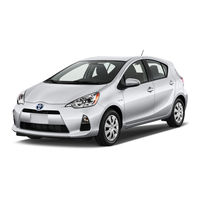Toyota Aqua 2013 Manuals
Manuals and User Guides for Toyota Aqua 2013. We have 1 Toyota Aqua 2013 manual available for free PDF download: Owner's Manual
Toyota Aqua 2013 Owner's Manual (550 pages)
Brand: Toyota
|
Category: Automobile
|
Size: 18.06 MB
Table of Contents
-
Symbols9
-
Exterior12
-
Interior14
-
Delays40
-
Luggage41
-
Keys42
-
Panic Mode60
-
Side Doors63
-
Back Door69
-
Front Seats74
-
Rear Seats75
-
Seat Belts82
-
Moon Roof99
-
Sunshade100
-
Refueling103
-
Fuel Types105
-
SRS Airbags113
-
Booster Seat134
-
Anchor Brackets137
-
Steering Lock165
-
EV Drive Mode169
-
Fuel Economy171
-
Eco Drive Mode173
-
Parking Brake176
-
Horn177
-
Engine Speed179
-
Indicators182
-
Warning Lights183
-
“Energy Monitor”188
-
Cruising Range190
-
“ECO Savings”192
-
Charge Area194
-
Hybrid Eco Area194
-
Eco Area194
-
Screen Settings195
-
Screen off198
-
Eco Savings199
-
Eco Score199
-
Headlight Switch201
-
Fog Light Switch205
-
Cruise Control214
-
Seating Capacity227
-
Trailer Towing232
-
Dinghy Towing233
-
Center Outlets240
-
About Bluetooth247
-
Using the Radio252
-
-
Scanning Tracks255
-
Random Playback255
-
Error Messages256
-
Display256
-
-
Selecting Files260
-
Scanning Files260
-
Repeat Play261
-
Compatible Media264
-
File Names264
-
Multi-Sessions264
-
Extensions265
-
Playback265
-
Control Panel266
-
-
Play Mode List267
-
Selecting a List268
-
Selecting Songs268
-
Shuffle Playback269
-
Cord Hook270
-
About Ipod270
-
Ipod Problems271
-
Ipod Functions271
-
-
Audio Unit293
-
Microphone294
-
Selecting Tracks298
-
Speed Dialing302
-
Inputting Digits304
-
Initialization311
-
Setting Ringtone317
-
Interior Lights320
-
Personal Lights320
-
Glove Box323
-
Console Box323
-
Auxiliary Boxes325
-
Rear (Type B)327
-
Front327
-
Rear (Type A)327
-
Cup Holders327
-
Bottle Holders328
-
Sun Visors330
-
Vanity Mirrors331
-
Power Outlet334
-
Seat Heaters335
-
Coat Hooks337
-
Assist Grips338
-
Floor Mat339
-
Luggage Cover341
-
Bumpers344
-
Aluminum Wheels344
-
Maintenance349
-
Vehicle Interior353
-
Vehicle Exterior355
-
Engine Oil366
-
Coolant370
-
Brake Fluid372
-
Adding Fluid373
-
Washer Fluid375
-
12-Volt Battery376
-
Location376
-
Tires381
-
Checking Tires381
-
Tire Rotation381
-
Tire Life384
-
Tire Types385
-
Summer Tires385
-
All Season Tires385
-
Snow Tires385
-
Wheels393
-
Wheel Selection393
-
Light Bulbs412
-
Front Fog Lights414
-
Parking Lights416
-
LED Light Bulbs422
-
Before Towing425
-
Emergency Towing425
-
Audible Symptoms430
-
Visible Symptoms430
-
Specifications489
-
Engine Number491
-
Cooling System493
-
Tires and Wheels497
-
15-Inch Tires497
-
16-Inch Tires497
-
Fuel Information499
-
Gasoline Quality499
-
Tire Information502
-
Full-Size Tire502
-
Tire Size505
-
Tire Dimensions505
-
Treadwear507
-
What to Do If...547
-
Warning Lights548
Advertisement
